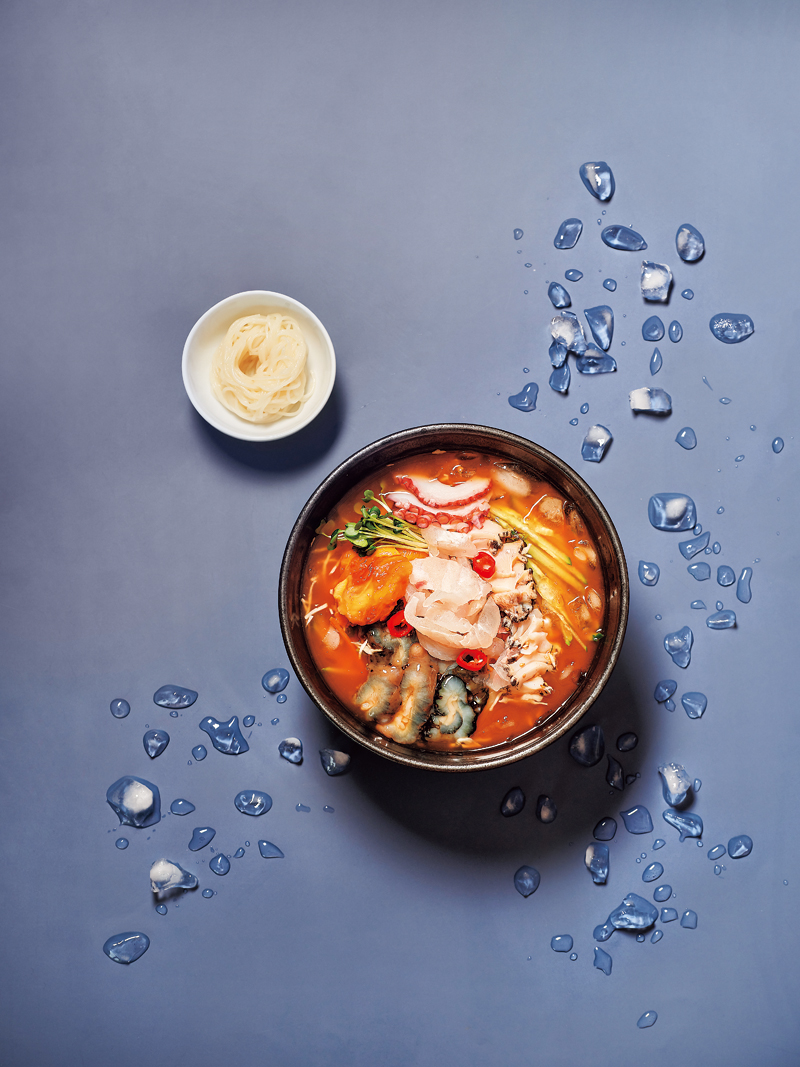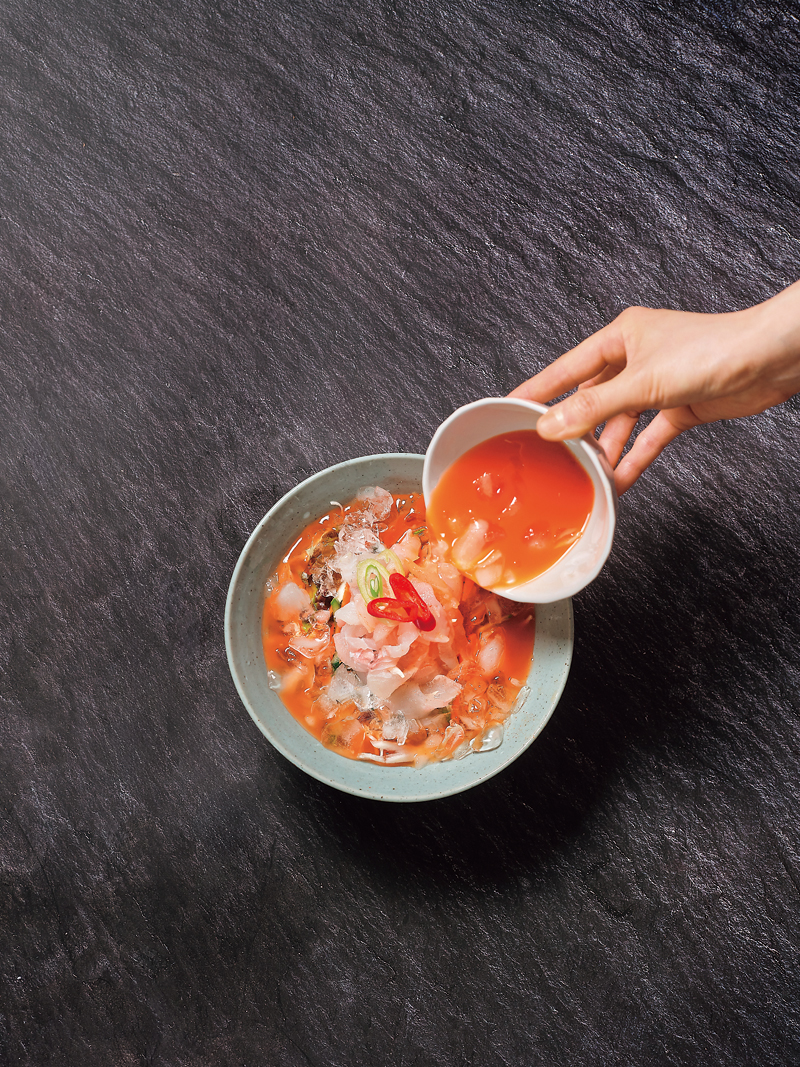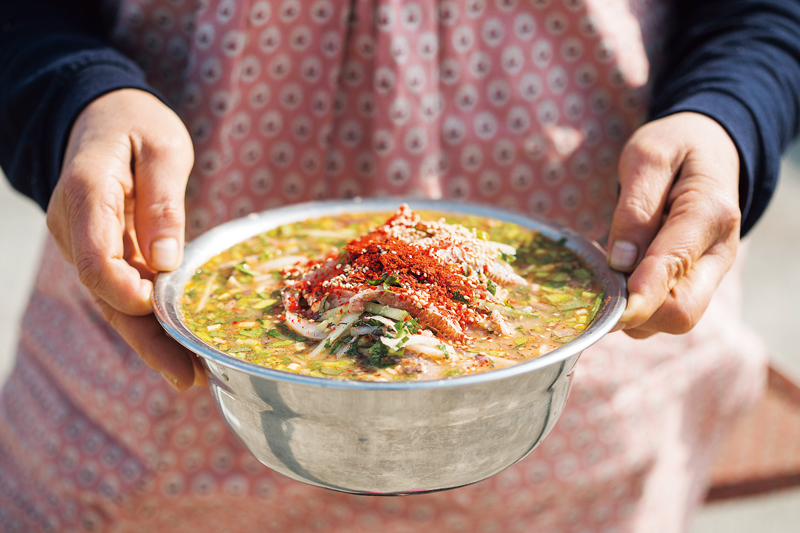Mulhoe was once a quick and easy meal eaten by fishermen on their wooden boats out at sea, where cooking over fire was not an option. The dish is rooted in Korea’s long-standing tradition of eating rice as a staple food, along with the culture of pairing freshly caught raw fish with
gochujang, fermented red chili paste. This combination of factors is what makes mulhoe a uniquely Korean specialty that cannot be found anywhere else in the world.

Thanks to its delightful blend of sliced raw fish, fresh seafood, and crunchy vegetables served in a refreshing broth made with gochujang, mulhoe is a widely sought-after delicacy synonymous with summer for many Koreans.
ACCORDING TO THE BIANNUAL STATE of World Fisheries and Aquaculture report by the UN Food and Agriculture Organization, South Korea consistently ranks among the top nations for per capita seafood consumption. Korea being surrounded by the sea on three sides certainly contributes to this trend but does not explain it entirely. After all, many other countries boast even longer coastlines than South Korea.
A NATION OF SEAFOOD LOVERS
One of the reasons South Koreans love seafood lies in their country’s culinary culture. Korea consumes a wider variety of seaweed than any other nation; this includes gim, miyeok, and dasima — laver, sea mustard, and kelp — as well as many other types of marine plants. The country is also a major exporter of seaweed, with the term used to refer to any plant that grows in the sea.
An abundance of seaweed is evidence of a healthy marine ecosystem teeming with life. Due to their shallow depths and proximity to land, the seas surrounding the Korean peninsula provide optimal growing conditions. Seaweed cannot thrive in deep waters, where it would not benefit from sunlight, or too far away from the shore, where the water contains fewer minerals. Thanks to the relative ease with which it can be harvested, Koreans have used seaweed to all sorts of dishes. This has afforded marine plants a central role in Korean culinary history, and in modern times, seaweed has become an essential component of a healthy Korean diet.
South Korea’s high consumption of seafood is also tied to the tradition of eating raw fish. This custom is only prevalent in a few countries across the world, most notably South Korea and Japan. In the Western world, such tradition can be seen in dishes like ceviche, recognized by UNESCO as an of traditional Peruvian cuisine, with variations native to other countries along the Pacific Ocean. However, the fish in ceviche is not completely raw but marinated in lemon or lime juice and seasonings, which cures it in a type of cooking process.
In contrast, South Korea and Japan have long embraced the practice of eating fish and other seafood raw, and it remains central to the culinary cultures of both countries. Raw fish is known as hoe in Korea and sashimi in Japan.
COMPLEX FLAVORS
There is a distinct difference between how raw fish is prepared in South Korea and Japan. In Japan, the fish is sliced up and then left for a certain period of time — at least a day — so that it develops a softer texture and more savory taste. Slices of sashimi prepared in this way are often eaten with rice mixed with vinegar, which helps prevent spoilage; this combination is known as sushi.
Koreans, on the other hand, prefer freshly prepared fish that retains a very firm texture and is often eaten with assorted sauces and vegetables. While Japanese people mostly limit sashimi condiments to soy sauce and wasabi to emphasize the fish’s flavor, Koreans enjoy hoe with soy sauce; doenjang (fermented soybean paste), gochujang, sesame oil, garlic; and even chili peppers. Lettuce or perilla leaves are often used to wrap the raw fish with one or more of these condiments, and the whole wrap is eaten as one texturally intense and delicious mouthful.
FISHERMEN’S FAST FOOD
Until the end of the Joseon Dynasty (1392–1910), Koreans used wooden rowing or sailing boats for all ocean fishing. Even after the introduction of motorized vessels, the majority of fishing boats continued to be made from wood. Boats with engines allowed fishermen to venture much further out to sea, resulting in longer journeys that required them to prepare and eat food on board.

Mulhoe’s spicy, tangy, and sweet broth offers the perfect combination of flavors to help restore one’s appetite on a hot summer day. After one has eaten the fresh slices of raw fish, seafood, and vegetables, it is common practice to finish the remaining broth together with rice or noodles.
Traditionally, rice and barley have been the main staples of the Korean diet, often prepared with the grains being dehusked and cooked whole. Compared to flour-based foods made from grains such as wheat or buckwheat, rice is usually far simpler to cook and retains more of its nutritional value. That said, cooked rice easily loses its moisture and returns to a hardened state when left out for too long.
Imagine the lives of Korean fishermen of the past. Setting off early in the morning for a day of fishing out in the open sea, they would have packed a large amount of bap, the Korean umbrella term used to refer to cooked rice and other grains, to eat aboard their boats. Their physically taxing labor would soon leave them hungry, but their bap would have just as quickly turned cold and hard, rendering it unappetizing. Boiling it in water could soften it up, but lighting a fire aboard a wooden boat was very risky. Instead, they came up with the idea of soaking it in cold water and adding thin slices of freshly caught fish with a spoonful of gochujang for extra flavor — a substitute for the side dishes they would have enjoyed on land. Thus, mulhoe can be seen as a kind of fast food devised by Korean fishermen that allowed them to revive and enjoy their bap. They could quickly wolf down this easily prepared meal while taking a short break from their strenuous work at sea.
DISTINCT REGIONAL DIFFERENCES
Mulhoe, which is always served cold and enjoyed for its delightful combination of refreshing soup and slices of freshly caught fish, has evolved from a humble fisherman’s dish into a delicacy that can now be found at any of South Korea’s seaside tourist destinations. The appealing flavor and textural balance between the soup, one or more types of fish, crunchy vegetables, and a serving of either rice or noodles has seen mulhoe become one of the most popular summer dishes to beat the stifling heat.
Meanwhile, more elaborate reinventions of mulhoe are gradually gaining in popularity. While its basic ingredients remain the same, the concept of mulhoe itself varies from region to region and even from one establishment to another, with each adding their own twists to a unique interpretation.

While mulhoe typically features a broth made with gochujang, Jeju islanders use doenjang instead. The bone-in slices of pearl-spot chromis, with their chewy texture and delicate taste, go well with the umami of the doenjang, resulting in a harmonious combination of flavors.
© VisitJeju
For most Koreans, the type of mulhoe that first comes to mind is the one commonly served in the coastal region of Yeongdong in Gangwon Province. This classic rendition consists of a soup made from either cold water or broth mixed with a tangy and spicy blend of gochujang, vinegar, and sugar. Flounder or a similar type of white fish is commonly used, although nearby Gangneung is famous for a variation including long strips of thinly sliced squid. There is even a nationwide restaurant chain called Cheongchosu Mulhoe, originally hailing from neighboring Sokcho, that specializes in this version. The chain also offers a popular dish called haejeon mulhoe, which consists of fresh abalone, sea cucumber, sea pineapple, octopus, flying fish roe, and a different type of fish depending on the season, all served together in a cold and savory beef broth. Throughout the year, people can be seen lining up to enjoy a taste of this famous mulhoe.
Pohang-style mulhoe uses gochujang as the main flavoring agent. This version stands out thanks to its slushy, frozen broth. With its generous topping of gochujang, the dish bears some resemblance to patbingsu, a traditional Korean dessert of finely shaved ice adorned with red bean paste. Pohang-style mulhoe offers a sweet and spicy taste, a contrast to Gangwon Province’s vinegary flavor. While this version may resemble bibimhoe, a similar dish without any broth, the slushy soup ensures that it remains cool until the last mouthful.
On Jeju Island, mulhoe has traditionally been prepared with a broth made from doenjang. This can be attributed to the fact that chili peppers have historically been scarcer on the island due to its geographical conditions. As a result, the majority of dishes on Jeju Island use doenjang over gochujang as the primary flavor base. The most famous type of Jeju mulhoe is made with a fish called jaridom, or pearl-spot chromis. Prickly-ash leaves are sometimes added to the soup to impart a unique fragrance, which helps minimize the fishy aftertaste. Jeju mulhoe is often eaten mixed with barley rice, while a small drop of glacial acetic acid is also added before serving to give the dish a tangy flavor. Thanks to the mild taste of the fish and the savory doenjang, Jeju mulhoe delivers a particularly harmonious combination of flavors.
Contemporary mulhoe dishes are prepared using different types of fish depending on the season and region, along with special sauces containing ingredients such as gochujang, sugar, sesame oil, vinegar, and soybean flour. Additionally, an increasing number of establishments have started using their own specially made broths instead of using water. The existence of so many different varieties has led to each region of Korea claiming to be the birthplace of mulhoe. It is precisely the absence of a definitive place of origin, however, that makes it such a culinary mystery, a characteristic shared by many other quintessentially Korean dishes. While it may appear humble at first glance, a closer look reveals a depth of complexity and nuance. One thing is certain: The hot and humid Korean summer would not be the same without it.